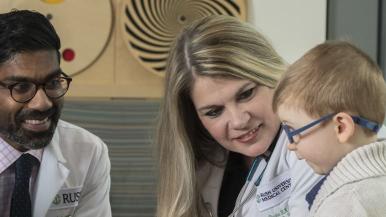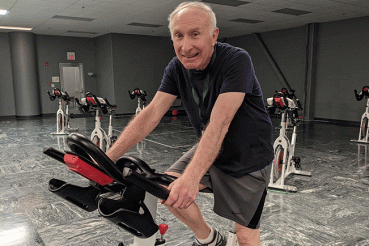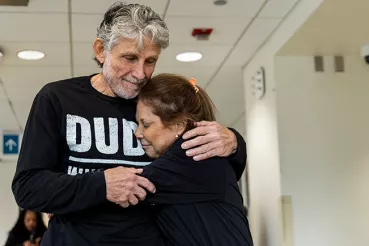Five days after Erin Moncek brought her newborn, Henry, home from the hospital, he stopped breathing and turned blue in his big brother’s arms. His parents rushed him to the emergency room of their local hospital, and he was hospitalized for five days. Henry’s doctors said he had a perfect storm of a mucus plug, reflux and apnea. But Erin had a sinking feeling that something more was going on with her baby.
As months went by, Henry had breathing issues and trouble feeding. He was growing slowly and was not hitting developmental milestones. “We knew something was wrong, but we didn’t know what,” says Erin.
Continued struggles
At 15 months old, Henry had two eye surgeries to correct severe congenital ptosis, a rare condition in which the upper eyelid droops and causes vision problems.
“After the second surgery, Henry woke up from anesthesia and was struggling to breathe,” Erin says. “It was the scariest moment of my life.”
Henry was admitted to the pediatric intensive care unit at their local hospital for five days. “He was a little vegetable for all intents and purposes,” Erin says. “I remember looking at him thinking, this is my baby, and there is something wrong with him.”
After that, Henry continued to struggle with developmental delays, breathing issues and feeding challenges. The Monceks spent about six months bouncing from specialist to specialist, getting few answers. “We didn’t know if it was just several different medical issues or one disorder causing all of his problems,” Erin says. “His doctors weren’t communicating with each other, and it became my responsibility to tell each doctor what the other said. It made an already difficult situation even more stressful.”
Coordinated care
That’s when Erin’s cousin, a health care advocate, recommended Rush University Children’s Hospital’s aerodigestive program — a multidisciplinary clinic that brings together pediatric specialists in ENT, gastroenterology, pulmonology and speech-language pathology. The clinic provides coordinated care and diagnosis to children with complex, often interrelated airway, digestive, feeding and sleep disorders.
At the clinic, Henry saw a pediatric otolaryngologist, pediatric gastroenterologist Anil Kesavan, MD, and pediatric pulmonary nurse practitioner Jenifer Burke, NP.
“I needed someone to hear me, and they did,” Erin says.
Erin soon felt the burden lifted. “Henry’s first few years were incredibly stressful; I felt like more of a nurse or caregiver than a mom, and I felt like I missed out on a lot,” she says. “Don’t get me wrong, I am still a nurse some days and a mom other days. But when we’re at Rush, I am able to just be Henry’s mom rather than the person relaying information from one doctor to another. The team at Rush didn’t put that on me.”
Answers, finally
Soon, Henry needed another eye surgery. At the same time, the Rush team wanted to run tests to see what was going on with Henry’s GI system and airways.
“Given his history with anesthesia complications, no one wanted to put him under multiple times, so they coordinated a whole ‘event’ for him with GI, ENT and ophthalmology, all working together,” says Erin.
Once again, Henry struggled as he came out of the anesthesia. But being at an academic medical center meant that Henry had access to a wide range of specialists to help him. Care was coordinated with several other pediatric specialists, and soon geneticists, neurologists and a speech pathologist became part of Henry’s care team.
“For me, the more people who knew what was happening with Henry, the better,” says Erin. “If one symptom resonated with them or something about him stuck out, then maybe we’d figure out what was going on with him.”
After Henry made it through the complications, his care team decided that a feeding tube would help with his feeding issues and growth delays. “That was the start in the right direction,” says Erin.
Additionally, Henry had a complete genetic workup with geneticist Carolyn Jones, MD. “The genetic tests found that Henry had a genetic mutation called BRPF1, which explained most of his symptoms: speech delays, low muscle tone, delay in walking, ptosis,” says Erin.
BRPF1 is an extremely rare genetic mutation; only about 20 people have ever been diagnosed with this mutation. However, just having an answer has helped the Monceks look ahead with hope
In addition to having answers, Erin also credits the support they received from Henry’s care team to getting them to where they are today. “Everyone at Rush has looked out for us and held our hands along the way,” says Erin. “They said, ‘Don’t worry, you’re not crazy, there is something going on with your son, and we’re going to help you get to the answer.’ And they did. They always wanted to do what was best for Henry and did everything they could to get us where we needed to be. They protected my baby and will forever be my angels.”
While Henry still has a feeding tube, he is working with a nutritionist, speech therapist and Kesavan and is continuing to thrive. “He’s growing, he’s happy, he’s active, his hair has grown in; he has become the kid that he should be,” Erin says.




